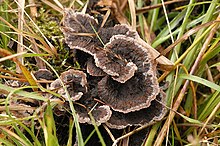Thelephora terrestris, commonly known as the common fiber vase[1] or earthfan fungus[2] is an inedible species of fungus in the Basidiomycota phylum.[3]
| Thelephora terrestris | |
|---|---|
 | |
| Scientific classification | |
| Domain: | Eukaryota |
| Kingdom: | Fungi |
| Division: | Basidiomycota |
| Class: | Agaricomycetes |
| Order: | Thelephorales |
| Family: | Thelephoraceae |
| Genus: | Thelephora |
| Species: | T. terrestris |
| Binomial name | |
| Thelephora terrestris Ehrh. (1787) | |
History and taxonomy
This fungus was first described by Jakob Friedrich Ehrhart in 1787.[4][5]
Habitat and ecology
Throughout North America[1] and Europe[5] Thelephora terrestris can be found in soil. It is commonly found in sandy soils under pine trees, on roots[1] and twigs.[6]
This ectomycorrhizal fungus forms a symbiotic relationship known as mycorrhizae, especially with Pinus species.[7] It is commonly found in pine forests[8] as well as plant nursery soils world wide.[9] This fungus is known to get water and nutrients from far away[10] and being capable of growing in both low fertility and high fertility soils.[2]
It is a dominant mycorrhizal fungus,[9] re-establishes quickly after disturbances such as forest fire, and is considered stress tolerant.[11]
Outside of the Pinus genus, it is also capable of forming mycorrizha with other trees such as alder, birch, oak, beech, and poplar.[2]
Thelephora terrestris virus 1 (TtV1), which is a mycovirus, can infect this fungus.[2]
Description
Thelephora terrestris is present year round, though is mostly seen July to December.[1] As the fruiting body forms, it starts off lighter in colour then turns to a darker shade of brown as it ages.[7] A stalk may not be present, if there is one, it is usually very short.[1] Sometimes the fungus is grown in large colonies.[6] The shape is described as a fan and can grow up to 6 cm wide.[6] It has been described to have a moldy earth like smell.[1]
| Thelephora terrestris | |
|---|---|
| Smooth hymenium | |
| No distinct cap | |
| Hymenium attachment is not applicable | |
| Stipe is bare | |
| Spore print is purple-brown | |
 | Ecology is mycorrhizal |
 | Edibility is inedible |
The hyphae of mycorrhizal forms walls that becomes thicker as it ages, while in earlier stages may be spiney.[12] When mating, the hyphae forms clamp connections[7] The spores are purple-brown colour,[1] ellipsoid or angular shape.[6]
The edibility of this fungus is unknown, but it is considered too tough to be worthwhile.[13]
Thelephora palmata is a similar species which is comparatively stinky and less widely distributed.[13][14]
Physiology
The full life cycle can be reproduced and studied in a laboratory, both ectomycorrhizal form and mushroom form.[15]
Due to the mycotoxins that the fungi produces, it protects pinus trees from root pathogen Phytophthora cinnamomi.[9]